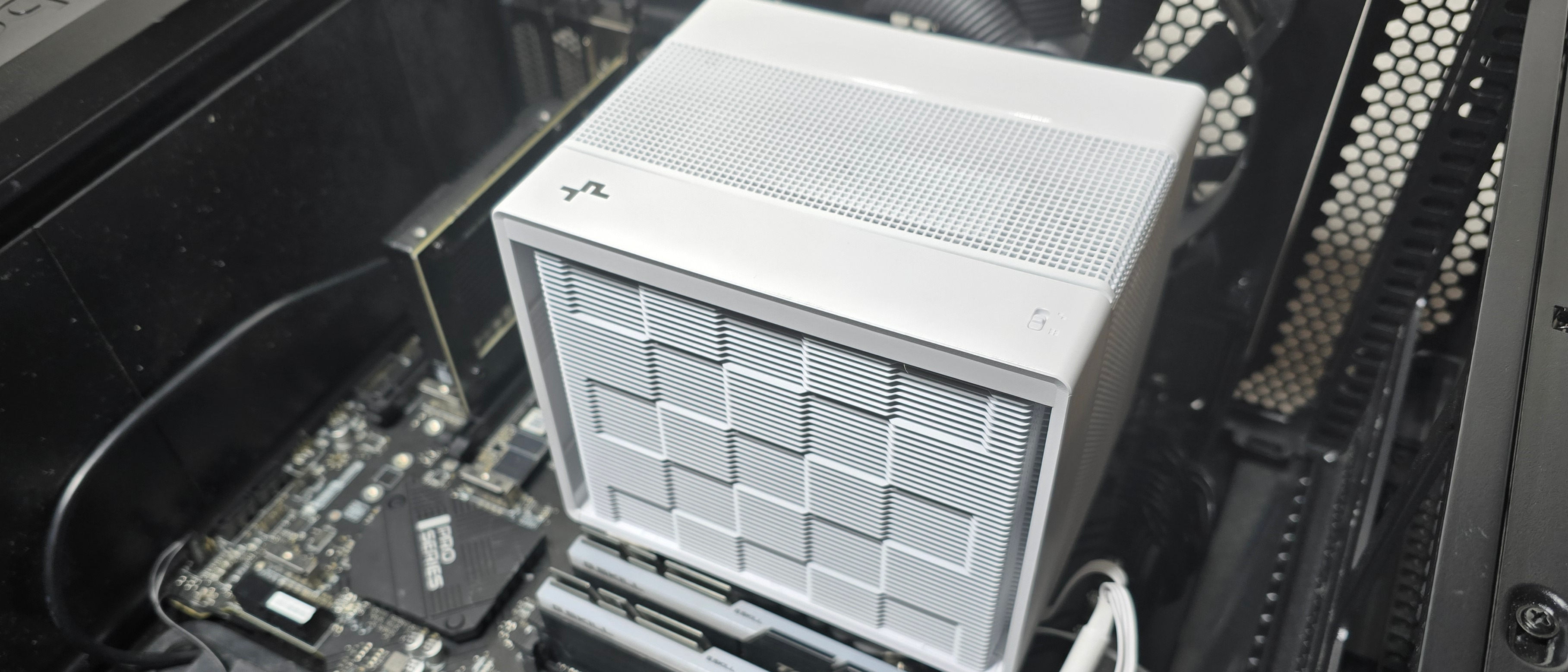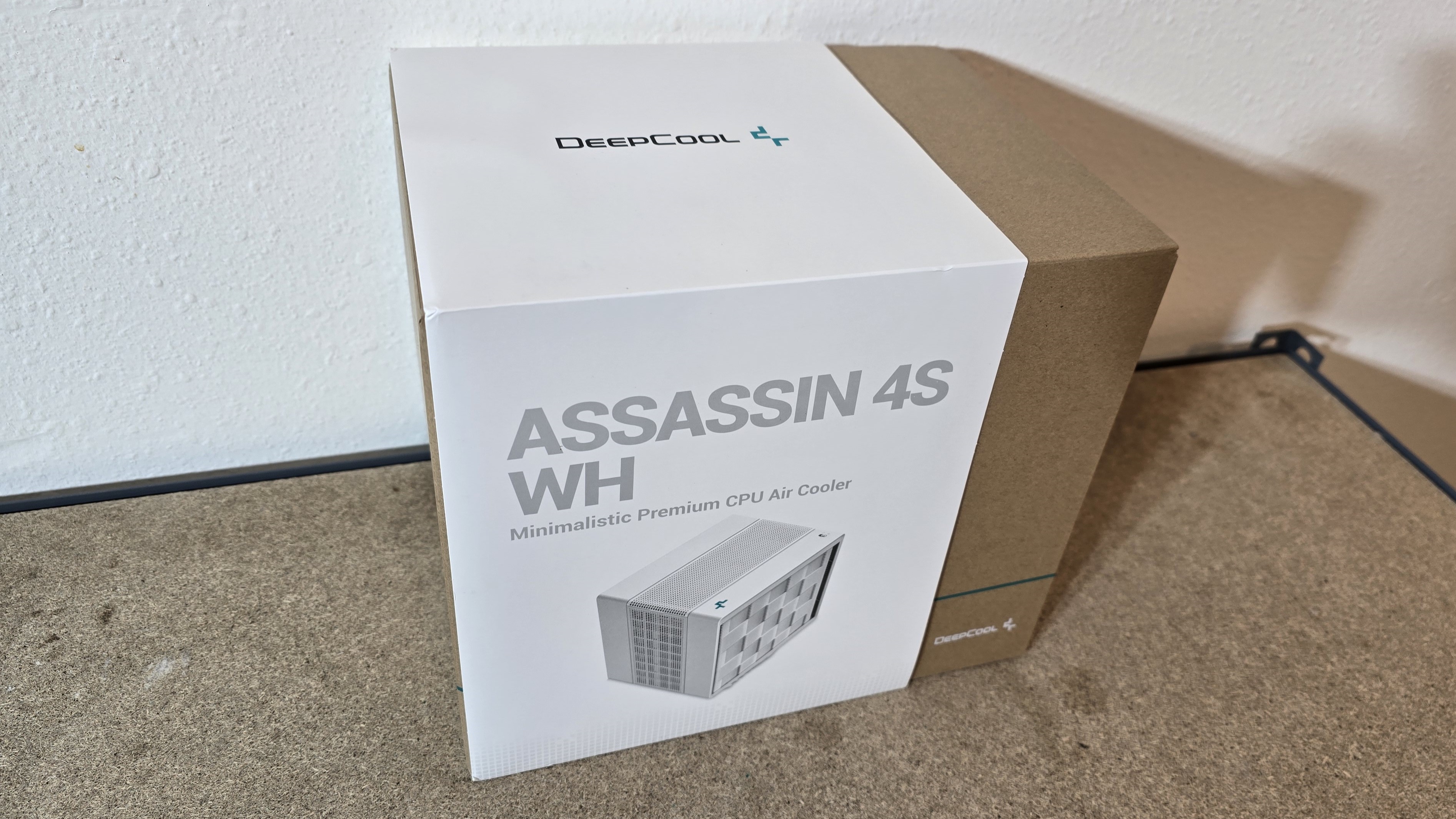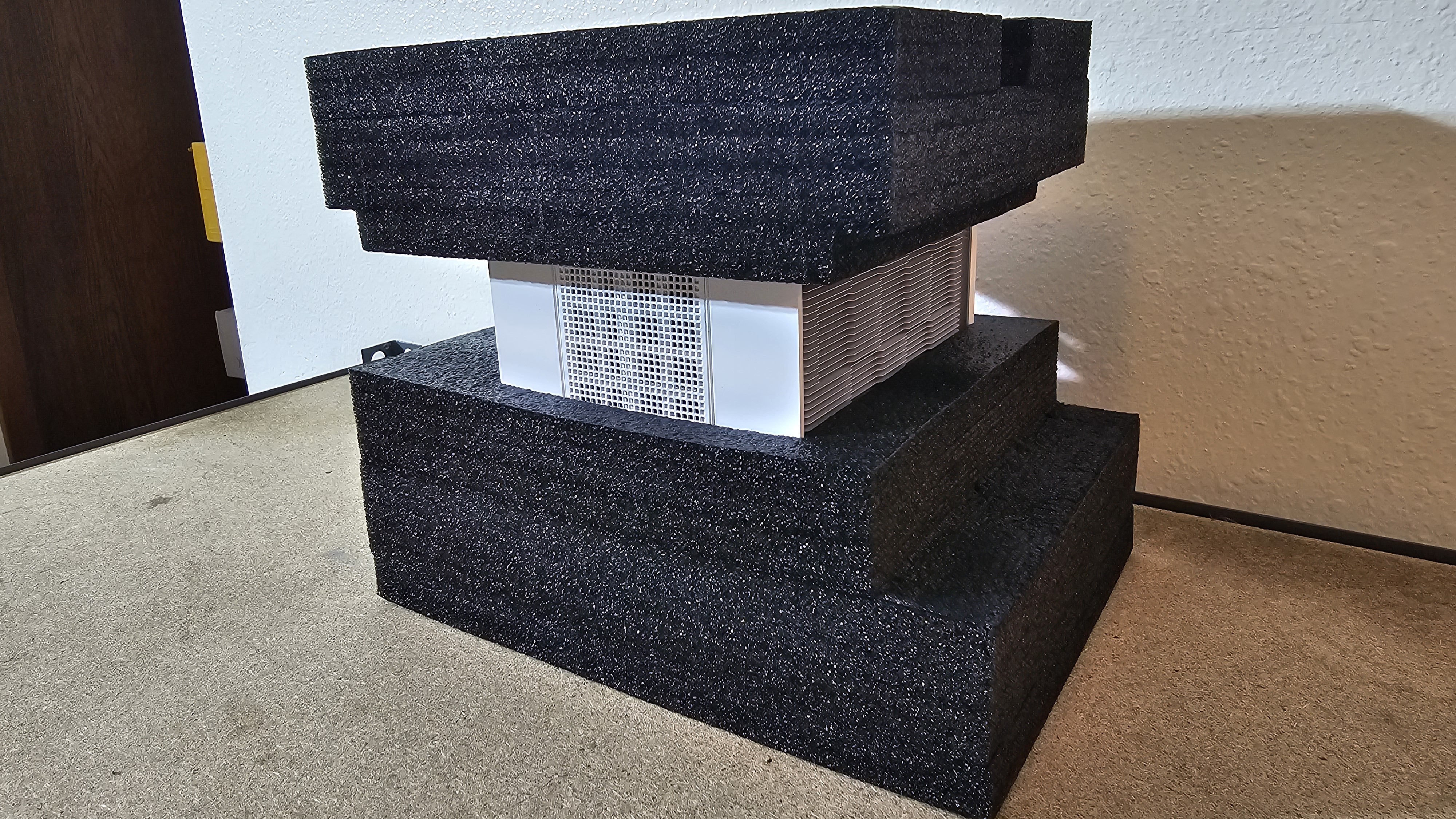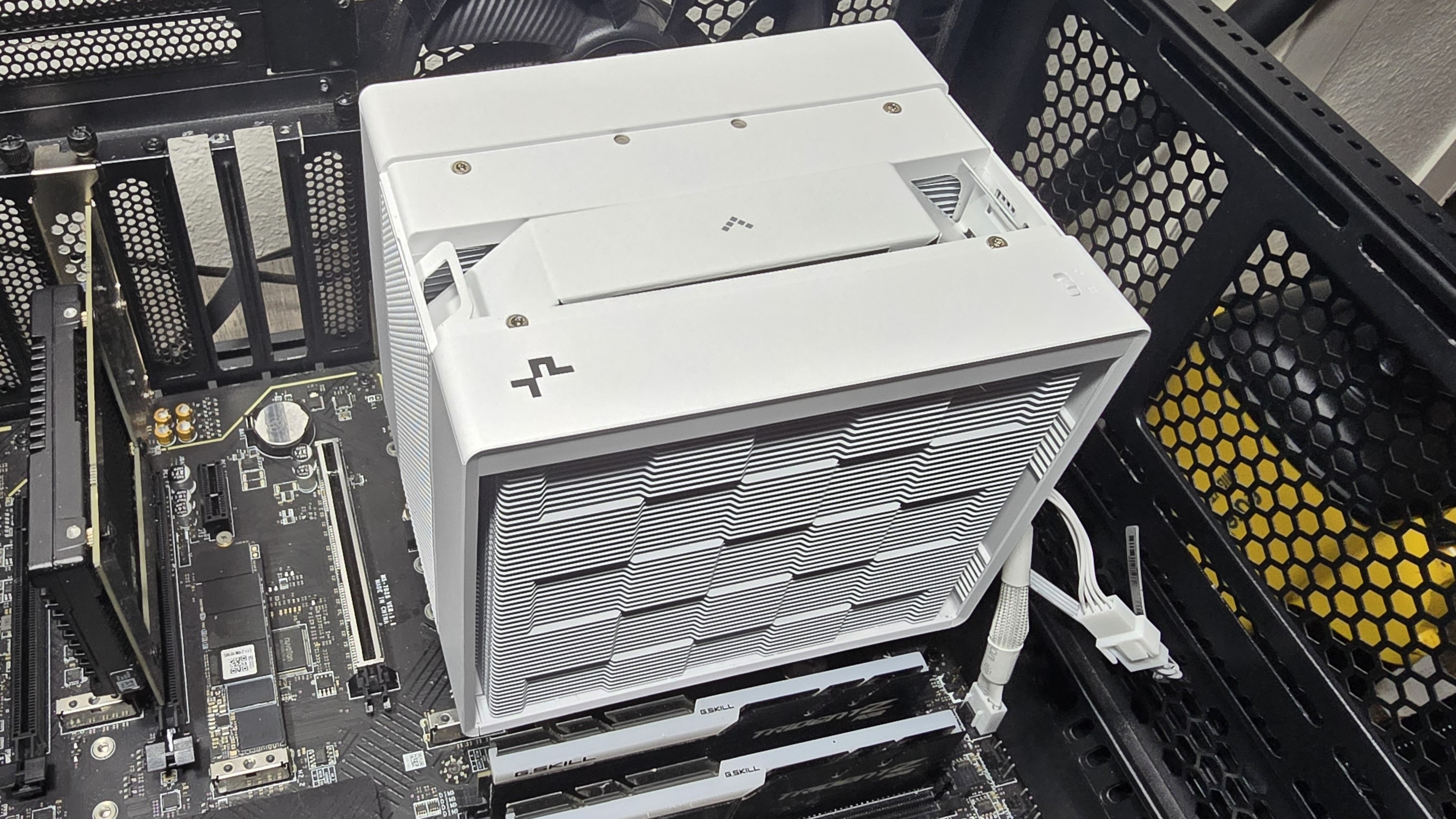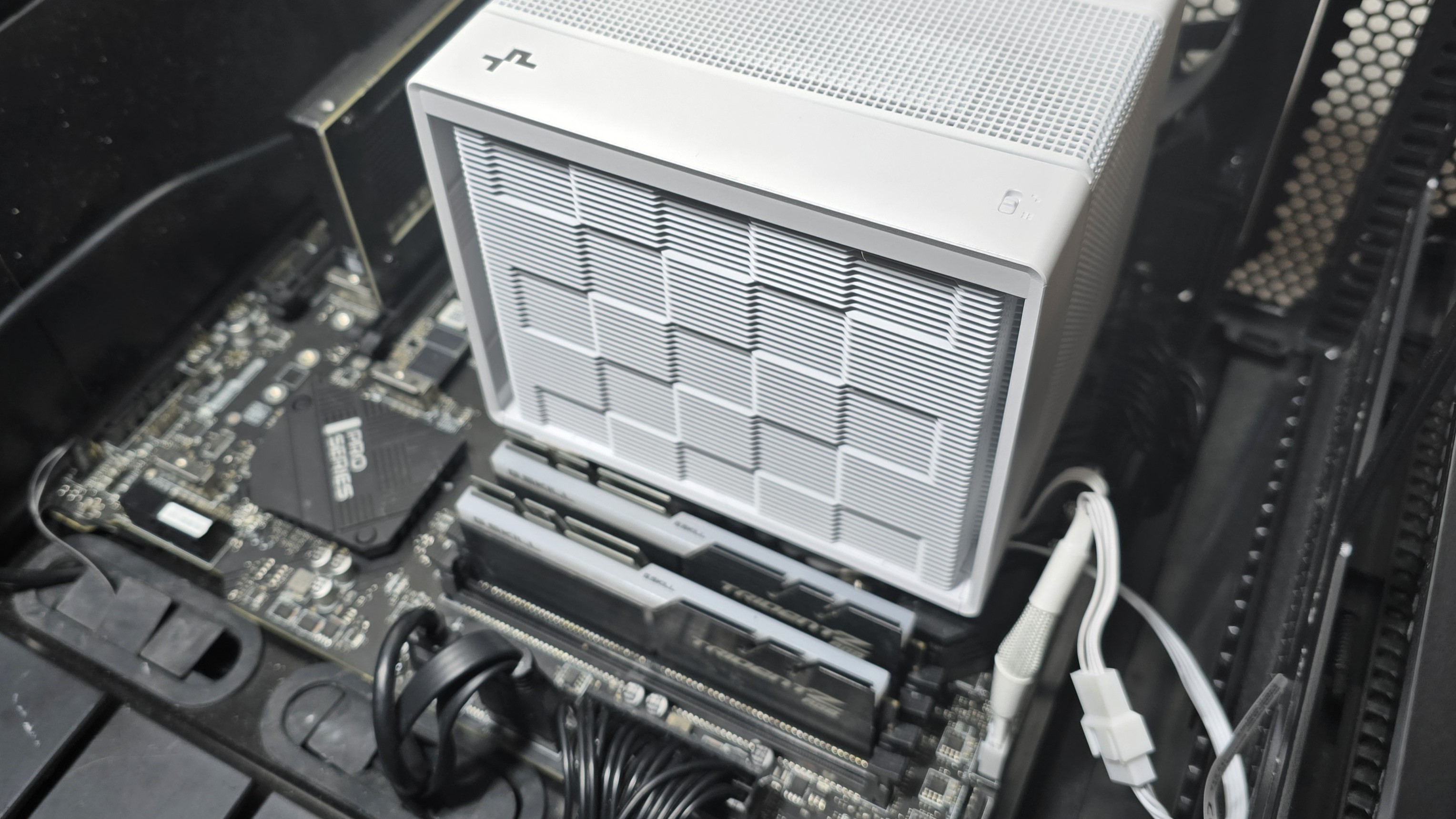Tom's Hardware Verdict
The Assassin 4S improves on its predecessor in most ways, and it offers a unique look. But its $80 price puts it in competition with excellent alternatives. And unlike its predecessor, you can't add a second fan for stronger performance.
Pros
- +
Lower noise levels vs the Assassin IV
- +
Improved noise-normalized performance
- +
Long 6-year of warranty
- +
Unique design
Cons
- -
$79.99 MSRP
- -
Can't add a second fan
Why you can trust Tom's Hardware
DeepCool is well known in the cooling and component world, having delivered innovative, interesting and budget-conscious PC products for more than a decade. Its current lineup includes air and AIO coolers, computer cases, keyboards, power supplies and other accessories.
Last summer we tested DeepCool’s Assassin IV, a cube-shaped cooler with a unique design, and found it to be one of the best CPU coolers on the market. Today, we’re looking at a reduced-price follow-up to the Assassin IV, the Assassin 4S. Does it have what it takes to stand out among excellent budget options like the Phantom Spirit 120 EVO? We’ll have to look at our benchmark results to say for sure. First, let’s look at the specifications of the cooler and what makes it different from the original version of the Assassin IV.
Cooler specifications
| Cooler | DeepCool Assassin 4S |
| MSRP | $79.99 |
| Heatsink Material | Aluminum |
| Heatpipes | 7x 6mm |
| Rated Lifespan | Unlisted |
| Socket Compatibility | Intel LGA 1700/115x/1200/2011/2066 AMD: AM5/AM4 |
| Base | Copper Base |
| Max TDP with Intel’s i7-13700K (Our Testing) | 232W |
| Dimensions | 116mm (L) x 147 mm (W) x 164mm (D) |
Packing and included contents
The heatsink is protected during shipping by molded cardboard and the accessories arrive in a compact brown box.
Included in the box are the following:
- Heatsink
- Mounting for modern AMD and Intel Platforms
- 1x 140mm fan
- DeepCool DM9 Thermal Paste
- Paste spreading tool
- Mounting accessories
- Instruction Manual
- Screwdriver
LGA 1700 installation
The installation of the cooler is unchanged from the original version of this cooler, and it’s simple to set up.
1. Press the backplate against the rear of the motherboard and then secure it using the included metal standoffs.
2. Place the mounting bars on top of the standoffs and secure them with the included thumbscrews.
Get Tom's Hardware's best news and in-depth reviews, straight to your inbox.
3. Next, you’ll need to apply thermal paste to the CPU. If you're unsure how to do that, see our How to Apply Thermal Paste primer.
4. Remove the fan from the heatsink and place the cooler on top of the CPU. Secure it using the screws in between the two towers, using the included screwdriver.
5. Secure the fan on the cooler using the included fan clips, and then connect the fan to the PWM header on your motherboard.
Features of DeepCool’s Assassin 4S
▶ Six-year warranty
Many manufacturers include just a two- or three-year warranty with their air coolers, a potential red flag that the manufacturer doesn’t have faith in the quality of its design. DeepCool, however, is fully confident in the quality of the Assassin 4S – backing it with an impressive six-year warranty.
▶ Matrix Checkerboard Fin Design
Like its predecessor and the AK series of air coolers, the Assassin 4S incorporates a checkerboard matrix fin design that’s said to help improve total static pressure.
▶ Complete RAM compatibility
DeepCool’s Assassin 4S doesn’t overhang DIMM slots in any manner, allowing for complete compatibility with all DDR4 and DDR5, no matter how tall your sticks are.
▶ Upgraded 140mm fan
There’s more to a cooler than just the heatsink and radiator. The fan or fans included have a large impact on a cooler’s performance and are directly responsible for how loudly it runs. In the case of the Assassin 4S, the fan is pretty much the only thing different in comparison to the previous model. There is only one 140mm spinner included with the Assassin 4S, and it has been upgraded for improved performance. It has seven larger fan blades instead of the nine slimmer fan blades included with the original model, and features improved static pressure ratings.
One complaint I have about the Assassin 4S is that DeepCool does not include the back fan bracket included with the Assassin IV, and it is not available to purchase separately – which means you won’t be able to add an additional fan, unless you’re willing to 3D print a custom mount.
| Model | Assassin 4S | Assassin 4 |
|---|---|---|
| Dimensions | 140 x 140 x 25mm | 140 x 140 x 25mm |
| Fan Speed | Up to 1700 RPM ± 10% | Up to 1800 RPM ± 10% |
| Air Flow | Up to 79.1 CFM | Up to 61.25 CFM |
| Air Pressure | Up to 2.44 mmAq | Up to 3.76 mmAq |
| Bearing Type | Fluid-Dynamic Bearing | Fluid-Dynamic Bearing |
| Lighting | None | None |
| MFFT | Unlisted, 6 Year Warranty | Unlisted, 6 Year Warranty |
LGA1700 Socket Bending
There are many factors other than the CPU cooler that can influence your cooling performance, including the case you use and the fans installed in it. A system's motherboard can also influence this, especially if it suffers from bending, which results in poor cooler contact with the CPU.
To prevent bending from impacting our cooling results, we’ve installed Thermalright’s LGA 1700 contact frame into our testing rig. If your motherboard is affected by bending, your thermal results will be worse than those shown below. Not all motherboards are affected equally by this issue. I tested Raptor Lake CPUs in two motherboards. And while one of them showed significant thermal improvements after installing Thermalright’s LGA1700 contact frame, the other motherboard showed no difference in temperatures whatsoever! Check out our review of the contact frame for more information.
Testing methodology
Today's highest-end CPUs, whether Intel or AMD, are difficult to cool in intensive workloads. In the past. reaching 95 degrees Celsius or more on a desktop CPU might have been a cause for concern. But with today’s top-end CPUs, this is considered normal operation. Similar behavior has been present in laptops for years due to cooling limitations in tight spaces.
All testing is performed with a 23C ambient room temperature. Multiple thermal tests are run on each CPU to test the cooler in a variety of conditions, and acoustic measurements are taken with each result. These tests include:
1. Noise normalized testing at low noise levels
2. “Out of the box”/default configuration thermal and acoustics testing
a. No power limits enforced
b. Because CPUs hit Tjmax in this scenario, the best way to compare cooling strength is by recording the total CPU package power consumption.
3. Thermal and acoustics testing in power-limited scenarios
a. Power limited to 175W to emulate a medium-intensity workload
b. Power limited to 125W to emulate a low-intensity workload
The thermal results included are for 10-minute testing runs. To be sure that was sufficiently long to tax the cooler, we tested both Thermalright’s Assassin X 120 R SE and DeepCool’s LT720 with a 30-minute Cinebench test with Intel’s i9-13900K for both 10 minutes and 30 minutes. The results didn’t change much at all with the longer test: The average clock speeds maintained dropped by 29 MHz on DeepCool’s LT720 and 31 MHz on Thermalright’s Assassin X 120 R SE. That’s an incredibly small 0.6% difference in clock speeds maintained, a margin of error difference that tells us that the 10-minute tests are indeed long enough to properly test the coolers.
Testing configuration – Intel LGA1700 platform

Albert Thomas is a contributor for Tom’s Hardware, primarily covering CPU cooling reviews.
-
MuddyChicken I’m currently trying this cooler and comparing it to the Fuma 3. I powered limited my 13900k for gaming. In your opinion which route would you go? There’s a difference of $30. The assassin 4s sure looks better cosmeticallyReply
